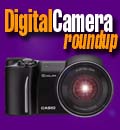 To most of us, the term digital camera means a nifty electronic/optical device to take pictures with, one that neatly fits into our hands and costs a few hundred dollars, like, for example, the handsome black Olympus C-5050 that's sitting on my desk. The 5050 has become part of my work which is reviewing products, writing articles, taking pictures, and creating magazines.
To most of us, the term digital camera means a nifty electronic/optical device to take pictures with, one that neatly fits into our hands and costs a few hundred dollars, like, for example, the handsome black Olympus C-5050 that's sitting on my desk. The 5050 has become part of my work which is reviewing products, writing articles, taking pictures, and creating magazines.
Digital imaging, however, goes far beyond just taking pictures of friends and family (or whatever floats your boat). Without digital imaging we wouldn't be able to view those breathtaking pictures of stars and galaxies many lightyears away taken by the Hubble space telescope. We couldn't peruse the surface of Mars in stunning clarity as if the pictures had been taken somewhere in a desert in Arizona. Of course, we also wouldn't get speeding tickets with incriminating pictures taken by automatically triggered robot cameras, but that's another story.
However, there is yet another area of digital imaging, one that saves lives. It is in medicine. Many areas of medicine use digital imaging for diagnostics, and recently I had the opportunity to witness that technology in action. On myself, in an area that I really never had a desire to see.
I had a flexible sigmoidoscopy, a procedure to scan for colorectal cancer. It is not something anyone does for fun. In fact, the mere mention of it makes most people cringe. Yet, I want to talk about it in this column because the procedure has saved untold lives and because some of the same names we feature in Digital Camera Magazine also make medical imaging equipment. The one used for my test was an Olympus Flexible Video Sigmoidoscope.
I had no idea of the extent digital imaging is used in medicine. Olympus alone makes imaging equipment and optical instruments used in allergy, anesthesiology, bariatric surgery, colon and rectal surgery, gastroenterology, general surgery, gynecology, neurosurgery, office endoscopy, orthopedics, otolaryngology, plastic surgery, pulmonology, urology and vascular surgery. Olympus' work in medical imaging is considered so valuable that the company has received numerous honors and awards, including, in 2003, one of Austria's highest national honors, the Gold Medal of Honor with Star. The award was presented to the chairman of Olympus Optical Company, Mr. Masatoshi Kishimoto, and read, "Through its developments in the area of medical technology Olympus has made a considerable contribution toward improving early diagnosis of cancer and moreover has, for many years, supported the charities Austrian Cancer League and Living with Cancer."
In the United States, Olympus helped sponsor the creation of "Colossal Colon," a 40-foot long and 4-foot high replica of a human colon. It is part of of a traveling exhibit meant to educate the public and reduce fears about sigmoidoscopy and colonoscopy exams. You can even take the tour online at checkyourinsidesout.org.
While the concept of a "Colossal Colon" sounds humorous, colon cancer is not. It is the second highest cause of cancer death in the United States, and also one that is most easily avoided via early detection. I will therefore do my part in allaying fears of sigmoidoscopy by telling you, firsthand, of my experience.
First of all, colon cancer can hit at any age, but once you reach middle age, a sigmoidoscopy is in order. Most doctors recommend that you have one around the age of 50. When one is prescribed, you need to fast for at least a day, and your insides must be cleaned out. For most people, that no longer requires the dreaded enema. I was simply given an instruction sheet that outlined what I needed to do.
My procedure was scheduled for 4:15pm Thursday. My last meal was Tuesday night. After that it was only clear liquids. I had to buy a 3 ounce bottle of Fleet Phospho Soda at a drugstore and take half of that the evening before and the second half the morning of the procedure. Phosbo Soda is bitter but not too bad. You drink it with water and then several glasses of water afterwards. Within an hour or so, whatever was in your intestants will be out. All of it. It's like an enema in a bottle.
I was apprehensive when I went to the clinic. When I showed the receptionist at the Kaiser Flexible Sigmoidoscopy clinic in Sacramento my identification card she smiled. "No need for ID. No one ever comes to us unless they have to." she said. Fortunately I didn't have to wait long. I had to strip and lay sideways on an examination bed. The doctor briefly explained the procedure. I took a deep breath and there was a sensation like that during a prostrate exam. After that it felt like I had rather severe gas. That's because the sigmoidoscope pumps air to inflate the colon. Other than that there was no pain. And though the sigmoidoscope measures an intimidating two feet, I could have never told. The doctor then asked me to turn around a bit so I could watch the high-res color monitor as she slowly retracted the camera scope with its 145 degree field of view. I saw my insides. It looked like a brightly lit pink tunnel, nice and smooth (and totally clean). The whole procedure was over in less than five minutes. After that I felt very gassy for a few hours, but there no pain. And I knew I had no colon cancer. Whew!
If you need this test, do not put it off. It is no big deal and it can save your life.
Digital imaging; it's not just cameras.








